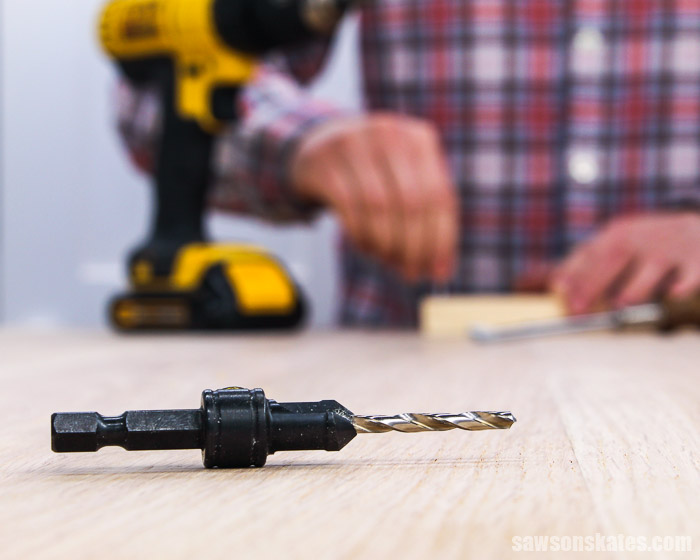Countersink bits are used for drilling pilot holes for screws and other fasteners, and for enlarging existing holes. They have a tapered tip and flutes that spiral up the bit, allowing it to cut cleanly through material without leaving a rough edge. The depth of the hole is adjustable, so you can control how far the screw or fastener will sink into the surface.
Countersink bits are used to create a conical hole in the material, which is then used to countersink a screw or bolt head so that it sits flush with the surface of the material. This is often done in woodworking projects, as well as for some metalworking applications.
Countersink drill bit. How to use countersink drill bit.
Types of Countersink Bits
There are different types of countersink bits available on the market, each designed for a specific application. Here is a rundown of the most common types:
Standard Countersink Bits – These are the most basic type of countersink bit and are typically used for drilling pilot holes in wood.
The point angle on these bits ranges from 82 to 90 degrees.
High-Speed Steel Countersink Bits – These bits are made from high-speed steel and are designed for use in harder materials such as metals. The point angle on these bits ranges from 118 to 135 degrees.
Carbide Tipped Countersink Bits – These bits feature a carbide tip that is designed for use in even harder materials such as stainless steel or cast iron. The point angle on these bits ranges from 118 to 135 degrees.

Credit: sawsonskates.com
Why Would You Countersink a Drilled Hole?
If you’re working with wood, it’s important to know how to countersink a drilled hole. Countersinking is the process of drilling a hole that’s slightly larger than the screw or bolt you’re using, so that the head of the screw or bolt sits flush with the surface of the material. This guide will show you how to countersink a drilled hole in four easy steps.
1. Measure the diameter of the screw or bolt you’re using, and add 1/16″ to that measurement. This is the size drill bit you’ll need to use for countersinking.
2. Drill a hole at your desired location, using the appropriate sized drill bit.
Make sure not to drill too deeply – you want the depth of your hole to be about half as deep as the length of your screw or bolt.
3. Place your countersink bit in your drill, and set it to stop just before it reaches bottom of your drilled hole. Slowly lower it into place, and begin drilling at a low speed until resistance is felt – then increase speed and continue drilling until complete.
Be careful not to over-countersink!
4. Remove debris from inside your newly created countersink, and insert your screw or bolt until tight – but don’t overtighten, which could strip out threads.
Do You Countersink before Drilling?
Countersinking is the process of drilling a hole that is slightly larger than the diameter of the screw or bolt being used. This allows the head of the screw or bolt to sit flush with, or below, the surface of the material. Countersinking can be done before or after drilling, but most experts recommend doing it before.
That way, if the drill bit wanders while you’re drilling, it won’t ruin the countersink.
Do You Need a Countersink Bit?
If you’re working with wood, then the answer is most likely yes – countersink bits are used to create a small indentation or “countersink” at the top of a drilled hole. This allows for the head of a screw or bolt to be flush with the surface of the wood (or whatever material you’re using).
Countersink bits come in various sizes, so it’s important to choose one that will match the size of the screws or bolts you’re using.
If you’re not sure, it’s always better to err on the side of a smaller bit size. You can always enlarge a hole if necessary, but it’s much more difficult (and sometimes impossible) to make a smaller hole larger.
To use a countersink bit, simply drill your hole as usual and then insert the countersink bit into your drill.
Drill slowly and carefully until you reach the desired depth – remember that you can always go deeper, but it’s very difficult (if not impossible) to make shallower indents.
Can You Countersink With a Regular Drill Bit?
You can countersink with a regular drill bit, but it’s not the ideal tool for the job. Countersinking is a machining operation in which the top surface of a workpiece is cut at an angle to create a conical hole. This hole is typically used to accommodate the head of a screw or bolt.
When countersinking, you want to drill a shallow hole that’s slightly wider than the screw or bolt you’re using. A regular drill bit will create a hole that’s too deep and too wide.
Conclusion
Countersink bits are used for drilling pilot holes and for countersinking screws. They have a conical shape and cutting flutes that taper down to the point. The tip of the bit is slightly larger than the screw shank diameter, which allows the screw to seat flush with or below the surface of the workpiece.
